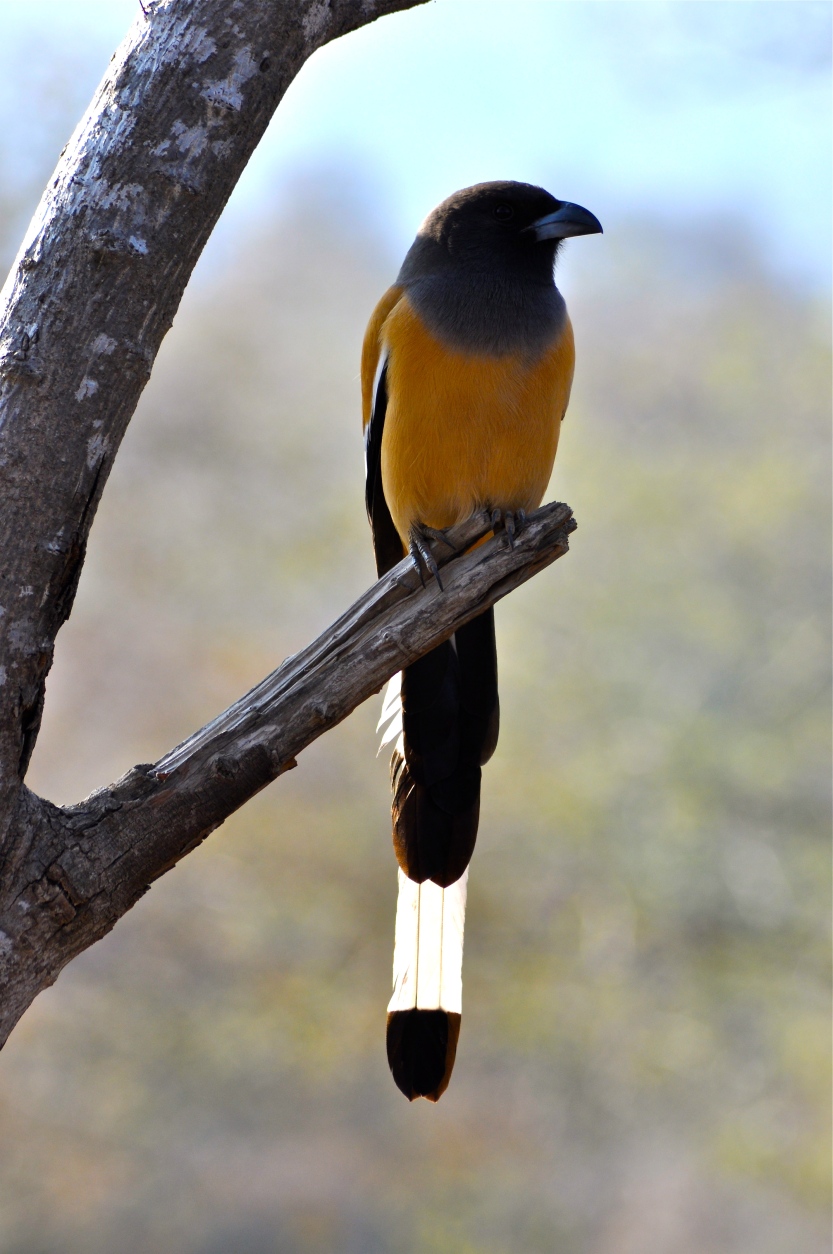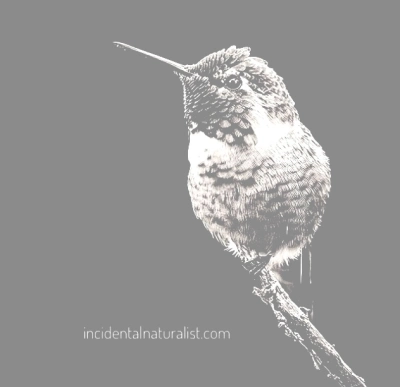India’s Ranthambhore National Park is an extraordinary place. Maintained as the private hunting preserve of the Maharajahs of Jaipur, in 1980 the Indian government declared the 392 km² (151 square miles) area a National Park, dedicated to the protection of tigers. This effort to preserve Rajasthan’s wild tigers has resulted in the creation of a habitat that supports not just the tiger and it’s prey, but an entire ecosystem.
I traveled for many miles to visit this ecosystem in the hope of catching a glimpse of the Royal Bengal tigers of Ranthambhore. While searching for the majestic cats I was fortunate to find myself surrounded by many other species of wildlife. Some beautiful, some spectacular, some fascinating but one of the most over-looked species was the ever-present Rufous treepie.

A member of the crow family and a colourful cousin of the black and white Eurasian magpie, that I am so familiar with, this striking bird grows up to 50 cm (19 inches) of which up to 30 cm (12 inches) is that splendid tail. The bird looks like it was cut from the left-over cloth that was used to make the park’s tigers, with its burnt amber body and black and white slashes like the stripes of the cat that it watches over.

Tiger spotting is a noisy, bone-shaking, nerve-jangling and dusty experience. We are rattled around like dried peas in a tin, over rough terrain in poorly maintained jeeps. During my safari, long periods of driving were punctuated by rest stops in open areas of the park. From the moment the driver killed the engine, the Rufous treepie, with its raucous squawk, was a constant companion. I unfurl my legs and clamber out of the Jeep nervously, in the hope that there are no big cats near by. The treepies appear from nowhere. It seems that each member of the party has a treepie for companionship, looking for scraps or crumbs.
The guide holds up his hand with a few snacks in his palm and within moments a treepie hops on to his outstretched hand and helps itself to a feast. We all do the same and within moments I feel the sharp needles of treepie claws on the ball of my hand and the prickle of a hooked beak plucking at biscuit crumbs. The bird feels incredibly light on the hand.

Like most members of the crow family, the Rufous treepie will eat pretty much anything, from fresh fruit to carrion and will even catch and kill baby birds and lizards as well as insects. Despite their taste for small amounts of farmer’s fruit, these birds are always forgiven due to the quantities of insect pests that they devour.
The Rufous treepie is common across India and much of south Asia and has a listed conservation status of least concern. Like the Eurasian magpie in the United Kingdom, it appears that being highly intelligent and an opportunistic feeder has been a recipe for success in the treepie’s ability to live alongside humans.
When it comes to wildlife, India has an embarrassment of riches. The Rufous treepie is not the most spectacular, the grandest or the most ornate. But it is a beautiful and confident little bird that engages on a personal level with people, and I will certainly seek them out if I have the opportunity to visit India again.

If you enjoyed this post, please follow Incidental Naturalist.
Comments below are welcomed.
Help others to connect with wildlife experiences by sharing this post on social media.
Categories: Asia





Great photo captur
LikeLiked by 1 person
Oh how stunningly beautiful! Your photographs and writing are wonderful. I am a nature lover too and delighted to have found your blog. When we were in India we spent an incredible 2 days in a bird park near Jaipur. We awoke before sunrise each day and spent the whole day watching birds, of which there was a great variety and quantity. Your post brought back lovely memories. How amazing to feed the rufous tree pie out of your hand. Simply beautiful! Thank you!
LikeLiked by 2 people
Thank you so much for your kind words! Jaipur is just beautiful isn’t it? So much history and so much wildlife as well as wonderful cultural and gastronomical experiences. It was great to feed these birds by hand. They were so friendly!
LikeLike
Have been reading about blackbirds (corvids) in an Audubon issue featuring these “brainiacs” of the birding word. Beautiful photos and text!
LikeLike
Am referring to your post with my “beautiful photos n text” comment 🙂
LikeLiked by 1 person
Thanks for the kind comment. Really, these birds, as with all corvids, appear to be very intelligent!
LikeLike
He’s one of the most stunning birds I’ve seen.
LikeLiked by 1 person
Such AMAZING photos and gorgeous birdies!
LikeLiked by 1 person
Thanks! 🙂
LikeLiked by 1 person
I’ve never been to India, but your description of the wildlife and your gorgeous shots make me want to. While I can see the crow like features it’s much prettier than our Australian crows! What beautiful colours and I love the long tail. Your shots are stunning, David. Perhaps one day I will make it out of Australia to see this wildlife for myself, but until then I am enjoying it from your wonderful blog. Thanks! 🙂
LikeLiked by 2 people
Thanks for your comment and kind words, Jane! What I have seen of India is gorgeous. An all-out assault on your senses! It seems to be a place that people either love or hate. I LOVED it! I’ll look forward to reading “Jane treks India”.
LikeLiked by 1 person
So beautiful! I love your pictures 🙂
It almost looks orange… orange is my favorite color.
LikeLiked by 2 people
Thank you! 🙂
LikeLike
“When it comes to wildlife, India has an embarrassment of riches.” Truer words have never been spoken.
I also like how you highlighted that many creatures, not just tigers, have benefited from Ranthambhore’s designation. One of the things I like about large, wide ranging predators is that their conservation has the potential to strengthen entire ecosystems.
LikeLiked by 2 people
Thanks for the comment, Josh! I believe that there is little point in saving an individual species if we are not going to preserve a habitat for the species to thrive in. As you point out, if the habitat can support a large predator then it is probably a healthy, well balanced ecosystem. This is what we must strive for, rather than a few caged or managed specimens.
LikeLiked by 1 person
thatamazing! congrats!
LikeLike
A beautiful Bird..and your photos are great..Love the post also with all the information..
LikeLiked by 1 person
Thanks for the encouraging comment. Glad you liked!
LikeLike
Absolutely gorgeous photography, David! 🙂
LikeLiked by 1 person
Thank you, Dina!
LikeLike
There are many Rufus treepie in Jaipur also. I have posted information and pictures of this bird on my blog too. Loved this post David
LikeLiked by 1 person
Thanks for the kind words! I’ll certainly revisit your blog to check out some previous posts.
LikeLiked by 1 person
Great. Here it is David. I wrote it long ago, when I started blogging. https://jaipurthrumylens.com/2015/10/13/rufous-treepie-jaipur-birders/
LikeLiked by 1 person
I am from Kerala.and Rufous Treepie is a common bird of Kerala.Can see village.town also in forest area.. Another species White bellied Treepie is also can see in forest area. We blesses with 520 bird species.
LikeLiked by 1 person
I have not yet visited Kerala. I certainly hope to do so some day. Perhaps I will see the White-bellies treepie then. Thanks for visit my blog and for taking the time to comment.
LikeLike